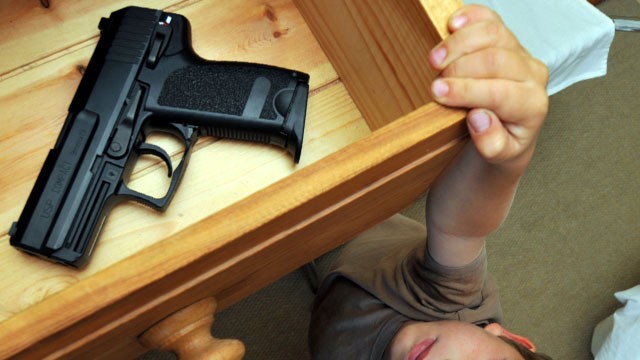Project: Targeting weapons - misuse of weapons in Serbia03Feb2016
A Gun as a Defense? The US Stats Say It’s More Likely to Harm Your Family
Politicians have been calling on Americans to arm themselves in the wake of the Paris and San Bernardino attacks, and industry reps say sales are up. But years of research say that keeping a gun in a home increases shooting risks.
Instead, what the available evidence indicates is this: Owning a gun increases your odds of being killed by a gun at the hands of someone you know.
 A 2014 meta-analysis of 16 studies by Dr. Andrew Anglemeyer and his colleagues at the University of California, San Francisco found that household gun ownership doubles the risk of homicide and triples the risk of suicide for those with access to firearms. Another study found that access to a firearm increases 12-fold the likelihood of an altercation with a family member or an intimate partner escalating to murder.
A 2014 meta-analysis of 16 studies by Dr. Andrew Anglemeyer and his colleagues at the University of California, San Francisco found that household gun ownership doubles the risk of homicide and triples the risk of suicide for those with access to firearms. Another study found that access to a firearm increases 12-fold the likelihood of an altercation with a family member or an intimate partner escalating to murder.
Adding to these findings, a 2014 study by Dr. Michael Siegel at Boston University found that gun ownership substantially increases the risk of homicide across the population. He also discovered that an even more interesting picture emerges when you break down homicides into those committed by strangers and those committed by non-strangers. The paper revealed that, while gun ownership is not associated with significant increases in the former category, for every 1 percent increase in gun ownership there was a 0.9 percent increase in murders carried out by people the gun owner knew.
A new study by Siegel and Dr. Emily Rothman further clarified this relationship, finding that increased levels of firearm ownership disproportionately impact women. Specifically, the study revealed that “for each 10 percentage point increase in state-level firearm ownership in a state, the female firearm-related homicide rate increases by 10.2 percent” — with 88 percent of these homicides being perpetrated by people the victim knew.
The fact is, as gun ownership rates increase, you are more likely to be killed by someone you know than by an unknown criminal. When you consider that having a gun in the home is a significant risk factor for suicide, then, on average, the very gun that was ostensibly purchased to protect your family from criminals is far more likely to be used on a member of your family than in defense of them. And these analyses only examine homicides and suicides, and don’t take into account other risks associated with gun ownership, such as fatal accidents. Consider that, in 2015, there were roughly 2,000 unintentional shootings, approximately 600 of which ended in death. Meanwhile, about 80 people each year die during a home invasion. Do the math, and the result is that the specter of a bad guy entering your home to murder you and your family is roughly 7 times less likely to happen than having your own gun accidentally used to kill an innocent person.
Outside of the home, the benefits of carrying a firearm in public are similarly overstated. The data consistently show that a gun owner is statistically unlikely to impede an active shooter, terrorist or otherwise. From 2000 to 2013, there were 160 active shootings catalogued by the FBI. In only one case was the shooter stopped by a concealed carry permit holder. He happened to be a U.S. Marine.
Beyond active shooter situations, defensive gun use of the everyday variety is also exceedingly rare. The Gun Violence Archive, a nonpartisan project that tracks gun homicides and non-fatal shootings, catalogued only 1,600 verified cases of defensive gun use in 2014 and 1,300 in 2015. A five-year Department of Justice report additionally found that, despite some 300 million firearms in circulation in the U.S., less than 1 percent of nonfatal violent crime victims actually use a gun in self-defense against a criminal — and even this total is likely a large overestimate. In fact, the best available evidence indicates that concealed carry does not reduce crime and likely increases aggravated assaults. Instead of reducing crime, in practice more firearms often means a larger payoff for criminals who rely on auto thefts and burglaries as a major source for guns.
Politicians like Marco Rubio and a few irresponsible sheriffs pander to people’s worst fears and paranoia, ignoring the very real risks that gun ownership entails or pretending they don’t matter. They promote buying a gun as the best and only way to protect oneself from a world full of danger. A country where both firearms and fear abound is a country where family members are mistaken for threats, and people get shot dead just for doing their job or showing concern for their fellow citizens. A good samaritan wasshot and killed in North Carolina last weekend as he tried to help a man whose car was stuck in a snow drift. The previous day in Arkansas, a volunteer firefighter who rushed to a medical emergency was fatally shot after being mistaken for an intruder. And a week ago, an Ohio man thought heheard someone break into his basement and accidently killed his teenage son.
(This article originally stated that in 2015, there were 2,000 unintentional shooting deaths. In fact, there 2,000 unintentional shootings that year, 600 of which ended in death. We regret the error.)
The article was republished within our PublicPolicyWeeklyNewsletter. If you wish to follow us please subscribe here



